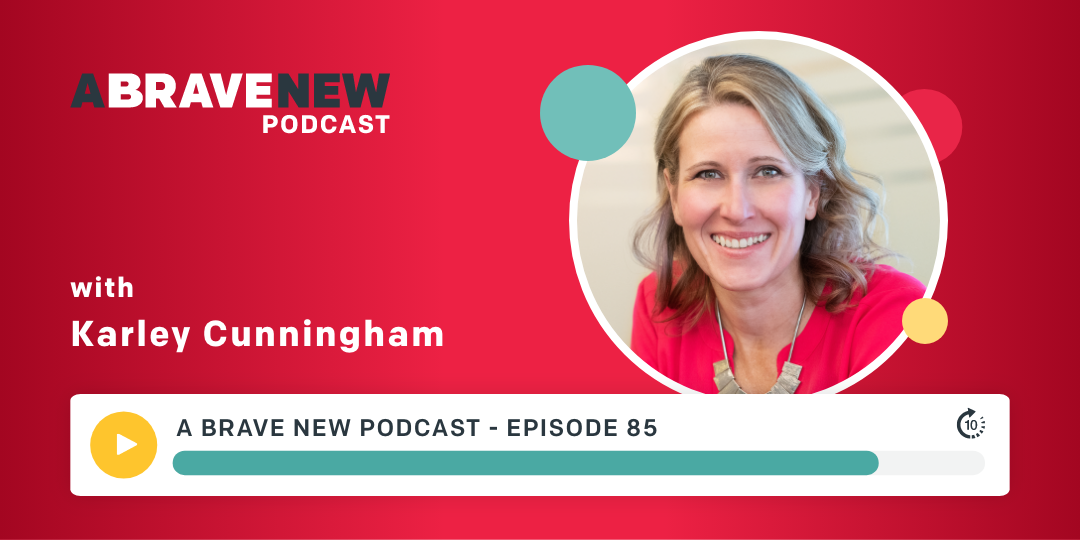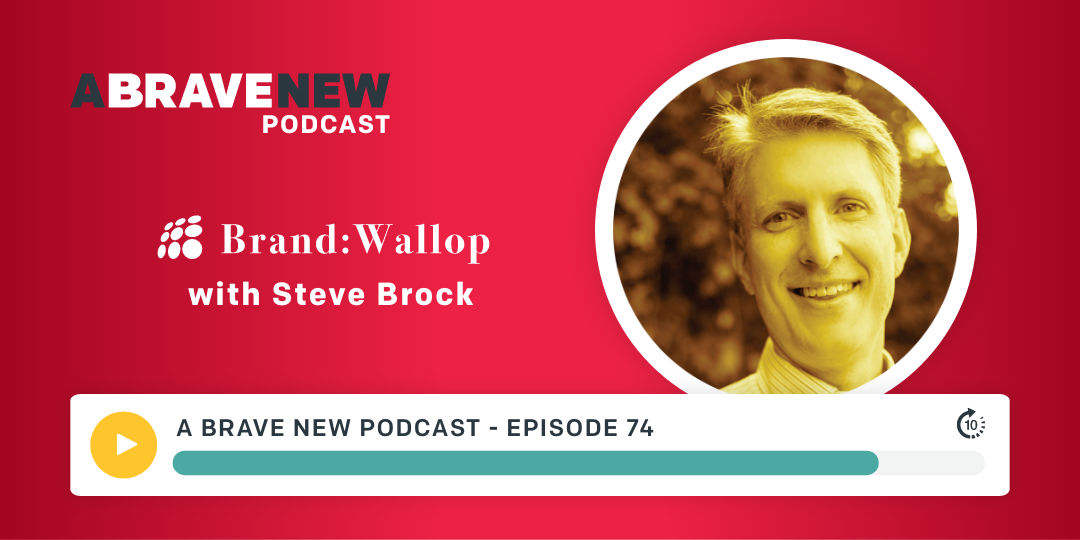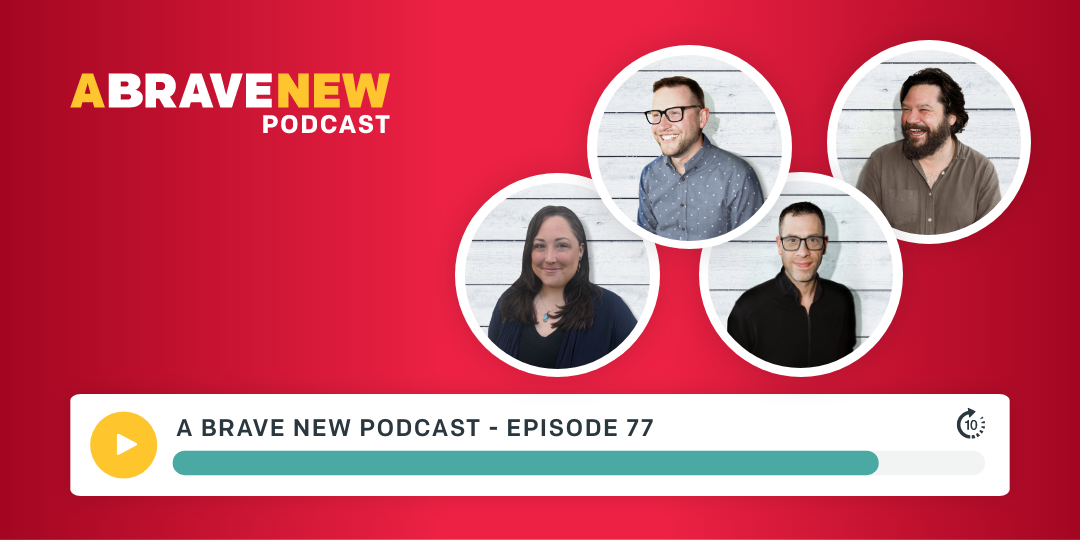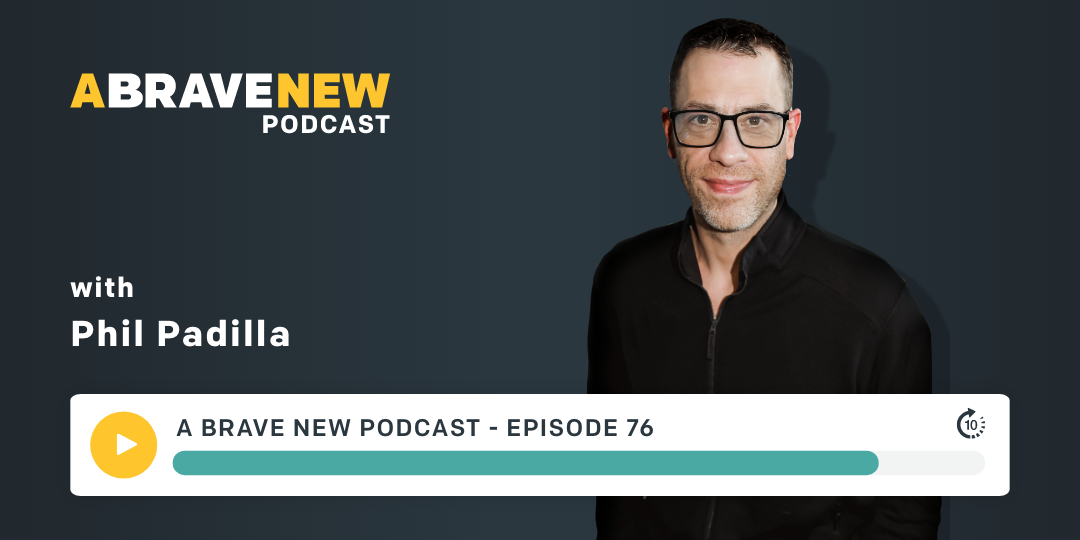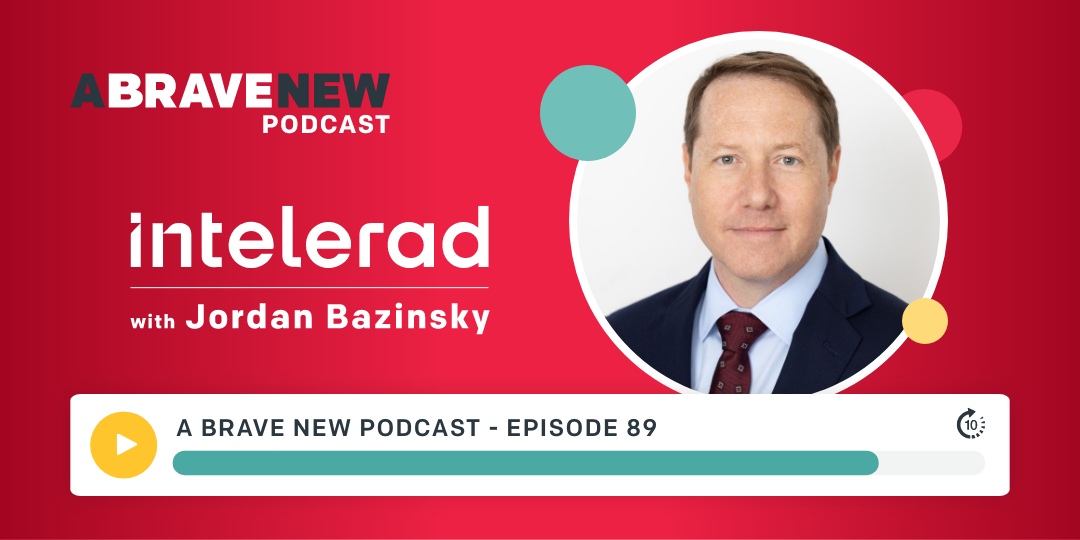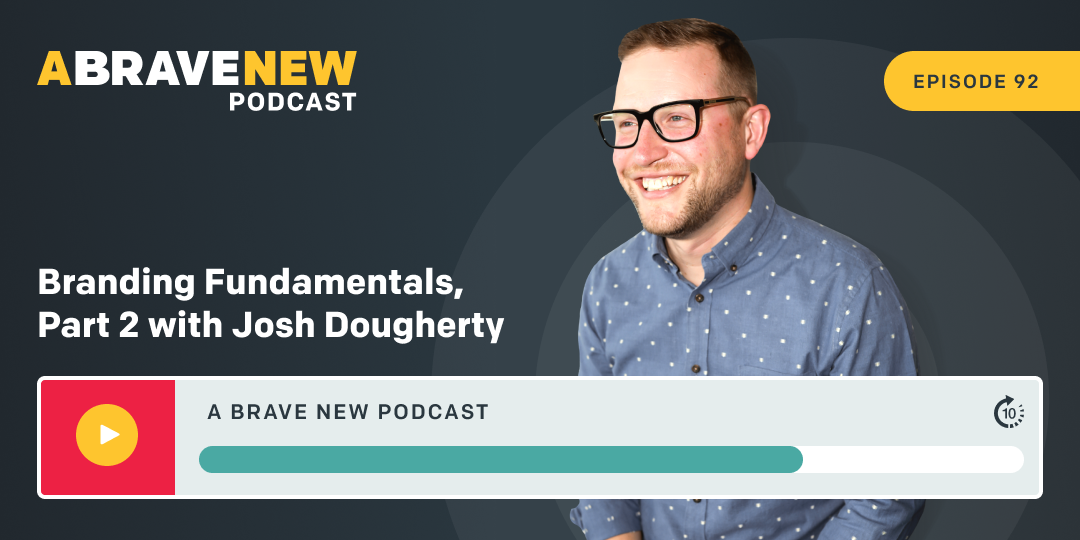A Brave New’s Art Director Phil Padilla brings with him over 15 years of experience, including 12 years of freelancing for some of the top Seattle creative agencies including Touch Worldwide and Hey, Advertising. Through this he has partnered with brands like Starbucks, Microsoft, and Philips to build expert branding and product development. His work has been recognized twice by the M Award for custom product packaging. Phil is a content creator consistently recognized by partners as being a story-builder, embracing change with enthusiasm, owning major project deliverables from beginning to end, and achieving positive business results.
What you’ll learn about in this episode:
- What makes our Art Director Phil Padilla tick and how he thinks about brand
- The key things Phil keeps in mind each and every time he embarks on a branding project
- Why McDonald’s and Nike have more in common than you think
- The importance of maintaining brand consistency across channels as you work on building your brand
- Why a little bit of fun is important and valuable for even the most serious brands
Additional resources:
Show Transcription:
Intro: Welcome to A Brave New Podcast, the podcast all about how big ideas, brave thinking, and marketing smarts help businesses grow. Here's your host, Josh Dougherty.
Josh: All right. Hello, and welcome to the latest episode of A Brave New Podcast. I'm your host, Josh Dougherty. Really happy to have you along with me. And today we have a special treat to have one of my colleagues at the agency, Phil Padilla, our art director here with us. Hey, Phil.
Phil: Hey, Josh. Thanks for having me today.
Josh: How are you doing?
Phil: I'm doing well, I'm doing well.
Josh: Nice. Well, I'm so excited to have Phil here, because he's the one that I really get to collaborate on on a day-to-day basis when we dive into a branding project. And so, I wanted to have him on to share a little bit about his unique perspective from the course of his career on building out really strong visual brands. And not only visual brands that are striking, but I think that connect in with the overall meaning behind a brand, which is really what a brand is all about. It isn't about just creating something that looks good, or sounds good from my background maybe as a writer, but something that conveys a meaning, a memory, an experience that people can get attached to. So, before we dive in Phil, I thought it'd be interesting because no-one's met you yet, at least on the podcast, for you to share a little bit about your story.
If you could tell our audience about your career path, where it's taking you. And obviously you're arrived here at a brave new now, been here a little while. But yeah, tell me a little bit about your story.
Phil: Sure, thank you. I'll start at the beginning, try to keep it concise. I was born in Santa Cruz, California, and migrated up here in grade school with my family. I think my desire for art really started to grow on family Sundays, when we would all gather together and watch The Simpsons. The art really resonated with me, and I noticed that I instantly had a knack for replicating what I saw, to quickly replicate and work out the proportions and sizing quite well. And it even got my own attention to the point where art was something that I continued to lean into, and in high school it got the attention of the lead graphic design instructor. And he highly encouraged me to try to do something with that art, and show some interest in this course, and he would love it if I joined them.
It was quickly something I embraced, I took him up on his offer, and one thing led to another, and the next thing I knew I was taking care of all the school functions. Whether it was a pep rally, or an assembly, or T-shirts for the homecoming, or the brochures, or the invites. Even a high school needs marketing collateral, right?
Josh: Yeah.
Phil: My love started to grow where it became something that I was like, "Whoa, I can actually do something with this." And I thought I was quite fortunate at the time, I was one of the only people I knew at that age that actually had a clear path ahead of them of what they knew they wanted to do, and what they wanted to pursue. And so, I worked with my graphic design instructor on assembling a portfolio, and applying for state art schools. And I quickly got accepted into one, and flourished there, and graduated. And right after I graduated, the dot com boom took place, and within just a couple of years of being a young, hungry graphic designer in the City of Seattle, I was quickly becoming the youngest dinosaur in town, because I was not formally trained on a lot of these rising categories.
So after working a few years in print and really honing in on the production side of graphic design, I knew it was time to really hone in on the digital side, and make those intentional changes in my career path to really build up that experience. And so I started freelancing, and really working with some of the bigger brands in Seattle, and honing in on my digital skillset. I worked with some great agencies, and really worked through and honed in on my own creative process, learning a little bit from every place you go. And it really started to take shape, and formulate as something of your own. And as you start moving into the senior and the art director positions, it really becomes something that you... Its' tried and true at that point, and you have your own twist on it, and your own approach. And it's something I'm very confident and proud of today.
Josh: Yeah, nice. I didn't know all the history, actually, as you were sharing design from such an early age, that's really cool to be able to pull that thread through all the way. Because I feel like a lot of us marketers never imagined that maybe we would be in the field that we were in, and I can speak for myself there. I was a history and Latin American Studies major in college, and so I never thought like, "Oh, I'll be running a marketing agency." But here I am, right? So, I think that's cool to see that threading. You've been working in agencies now for like the past decade, right?
Phil: Yeah.
Josh: Doing digital design, that sort of thing?
Phil: Yeah, for the most part. The last 15 years I've been working with some of the top agencies in Seattle, I've been looking to partner up with some of the smaller agencies. They've brought me in full-time, and it's just been a natural evolution of where my career path has led. And I looked up, and I was at a brave new doorstep. So, it's a great place to make home.
Josh: We feel lucky to have you now, so thanks for joining the team, and kind of investing your talents here. I'd love to talk a little bit about brand, obviously we spend a lot of time talking about branding as an organization. I think you and I spend a lot of time thinking about what are the different pieces of a brand that... How do they fit together? But, can you tell me a little bit about why you love branding projects, and what you think their ultimate impact is.
Phil: Absolutely, absolutely. The portions that really resonated with myself when it comes to branding are the deeper layers and nuances that are affiliated with it. I think at first thought, most people would think, "Okay, the colors, the font, the imagery and the logos," and I think that's a fair assessment of a brand at first sight. But I think there's a lot of layers that go into it, such as building something that's relatable to your demo, or something that supports your messaging, and really honing in on the psychology of it, and really trying to better understand why somebody might relate to that value proposition, why somebody might relate better to that tone in their copywriting, and why those colors might resonate and become a component of a memorable experience.
And the more I see brands take shape in the digital era, it starts to take its own shape and form. I think of brands as something that could be your best friend. You often hear that the reference of brands are what people say about you when you're not in the room, and brand's typically never in the room. And with today's digital channels, they have such a strong voice and tone on social media that they really start to take the shape of these personas, and best friend-like... I don't know what's the right word, but they take human personas, and I think they carry a lot of relatable aspects away.
Josh: Yeah, I know what you're talking about. Because for the brands that I relate to the most, when you interact with them, or when... I mean, a lot of mine are experiential, like I'm a big soccer fan. And so whenever I show up at the Sounders, it feels comfortable, like I'm at home. It feels like I'm meeting up with an old friend. And certainly there's other friends that I'm interacting with at the same time, but part of it is the experience that the brand's made that makes me feel instantly welcomed in any experience I have with them. So I get that thought and it comes through, in social media it comes through in a broadcast, it comes through maybe even in email when I receive... You have so many I think values stored up inside your head about how you perceive that brand that they start popping out whenever you're interacting with them.
Phil: And one aspect I love about it is it's made mistakes okay, you know?
Josh: Yeah.
Phil: A long time ago if you had a spelling error on a direct mail piece, that was a big mess up in the proofing system. But today, if you have a misspelling or something that's a little bit I guess just font, and maybe not marketing-driven, it's acceptable.
Josh: Totally.
Phil: To have those human errors, and to be human.
Josh: Yeah. And people forgive a lot when they're attached to something, right?
Phil: That's right.
Josh: I know, I was just kind of laughing as you were talking about the printers, because I began my career in that phase too. And it's just like, I remember the ultimate anxiety of when you sent out a million pieces of something, and you find out that you had an apostrophe in the wrong place. Like, oh my God, the stress. I was a copywriter, so I got away from a lot of it. But I know our production managers were always pulling their hair out on the day things were dropping. I always like to talk about a brand as being essentially a memory, right?
Phil: Mm-hmm (affirmative).
Josh: And so it's this idea that... I think when you said it's that thing that people say when you're not in the room, it's the memory that you leave behind, or that a company leaves behind in their customer's mind. To get a little bit nerdy into your craft, how do you think brand visuals can help create or cultivate that memory?
Phil: Yeah, I think that's a great question. And I think brand visuals need to really first of all capture the context of the messaging. But more importantly, I think they also need to kind of be that best friend that we just spoke of a few minutes ago, and take the opportunity to be informative, to be relatable, to be educational, and really start to hone in on memorable experiences by relating to values and some of those core human elements that I really think... Those are the pieces that really resonate with people. And I think it's also about approach, if you can teach them something new, or show them something different, the approach... The impression is much longer, it's long-lasting at that point.
Josh: Yeah. What are kind of the key tools that you use? So, you're using I imagine color can even be a powerful tool, but I'd love to hear... Maybe I'm going a little off-script, so you can decide whether or not you can go here. But I'm wondering about like, what are some of the brands that you think do the best at leaving that memory instantly? What are the ones that come to mind for you?
Phil: Well, I think I have two suspects that come to mind with that question. First off, McDonald's has been nailing it for decades now. You know, the strong use of red and yellow stimulates hunger, and really brings a little bit of that impulsiveness. So, those colors are very intentionally used when it comes to fast food, and really trying to be the spark in hunger, and opening that thought process. But my mind naturally gravitates towards the Nike experience, a full, encompassing experience. And the reason why I say that is because, if you get an email from Nike, or you decide to go shopping for a pair of shoes on their website, whether that's desktop or mobile, and then you actually... You follow through with an order, and you wait the five, seven days for your order to show up.
And you unbox the shoes, and you put them on, and you walk around the room, and they're very comfortable, they're light, they're everything you expected. That's a full, encompassing experience when the digital web experience matches the real life experience of actually experiencing the product, the touch, the feel and smell, bringing that brand experience full circle in-home, and really having it match the same expectations that you delivered on a digital level when you first sparked that new interest, whether it be in a service or product. It's almost unrivaled, I think you can mention some of the bigger names like Apple. But I really look at that full, encompassing experience.
Josh: Yeah, I think Nike's amazing from that perspective, I think of when I get new shoes or something along those lines. Shoes not typically for me, because I don't... Nike shoes are too narrow, I'm always trying to... But the experience is so good, maybe this goes to proving your point. I keep going back and trying to buy Nike shoes, because the experience feels so good when you're doing it. It feels consistent, and it speaks to kind of the aspirations about how I want to think about myself. So, I keep going back to the specific running shoes and soccer pleats that I want to get from Nike. They never fit, and I still buy them. So, maybe that's the brand working on me, right?
Phil: [crosstalk 00:14:12] certainly showed you the value.
Josh: Yeah, exactly. They've at least got me to imagine who I am differently. What do you think... As someone's getting involved, beginning to create that type of experience, many of us don't have that type of budget to pull off a Nike or an Apple experience. But I could say our culture is a bit cruel. We all expect that experience from every brand, even though most people don't have millions of dollars to create it. So if you're talking to someone who's thinking like, "We've really got to uplevel our brand, we've got to uplevel the experience we're providing," what are some of the most important things to keep in mind as you begin working on a project like that? Or, what are maybe some of the tools or principles that someone could use to help them start upleveling that experiencing themselves?
Phil: Yeah, that's a very good question. And whenever I start a new project or I want to take a moment and understand how we can improve an existing project, it starts with research. Research is the cornerstone of the design in the copywriting industry, it's almost like 90% research, 10% execution.
Josh: Totally.
Phil: But really, it goes deeper to research. Most people think of instant competitive analysis, or learning the market. But I really like to have a heavy emphasis and focus on the demographic and the users, and how we can best speak to them and relate to them. I think establishing depth to the personas beyond the age type and the gender, and some of the obvious assumed traits that might be affiliated with that demo. I think learning more about what makes them tick, what makes them smile, how they text with friends, in the various short-mannered direct messages. Do they use the letter U instead of spelling Y-O-U? I think understanding some of those deeper levels of what makes them tick as people, the better you can understand that the better you can speak to them.
And really, have you ever gone into a room and you size up your audience before you choose your words? It's your opportunity to size up your audience before you choose your visuals. And I really think that the deeper you dive there, the better informed you can be with decisions down the line.
Josh: Yeah, I like that a lot, because then if you really understand someone, you can do something that will feel right to them, or relevant to them regardless of your budget, whether you have $100,000 to execute your brand, you have $20,000, or you have $2 million, it's really about then, you're able to meet someone where they're at with a small gesture or a big gesture, and create something that's cohesive and cool. How do you think the discipline is changing? I feel like we've had some conversations about how the web is changing, and we're headed rapidly to Web 3.0. We're in the heat of understanding what blockchain is going to do to transform our industry. And yet, I think oftentimes we think about brand as this discipline that is maybe more stable than the technology disciplines. But I also think it's evolving, so I'd be interested in your thoughts of, what's changing in this field?
Phil: Yeah. Well, the tech field changes so rapidly, and I think that's a huge part nowadays in any brand, that reaches far beyond the standard colors and fonts that typically showcases the brand on the cover of the book. And I think that's where I see most brands struggle, I'll use the example of a website today that might not have a mobile responsive element to it. And that's just a quick example that I think we can all relate to, because it's visual, you can instantly see it, it sticks out like a sore thumb. Now, imagine that same example on the back end where clients, partners aren't keeping up with lead generation, or the ability to schedule an appointment, or the ability to upsell on the checkout process, or really start honing in on further opportunity to really convert and build a community.
And so that mobile reference I made was just a quick thing I think that we could wrap our head around. But there's so much going on on the back end of the site that really captured the functionality of what's expected today.
Josh: Totally.
Phil: That's where I see tech moving so rapidly that it's really hard for some branches to keep up with.
Josh: Yeah. And then I think certainly the promise is the same, but to fulfill on your promise that you're trying to fulfill from your brand with technology changing can be so difficult, I agree. And I think people also get tripped up in what they're doing, where they try to get so complex, where they can fail that way too. So, when do you think most people self-identify that they need help? I can think of some of the clients that we talk to and it's like, "Man, you should have self-identified way earlier that you needed help with your brand." Others are doing really well, and maybe there's improvements that they can do but they've done a pretty good job themselves. But, what does someone need to do to kind of...
Or what are the tools someone can use to maybe self-diagnose when they need to be thinking about revamping their brand beyond maybe just redoing their website, or reworking some collateral? What are some of the warning signs that you would look for to say, "Hey, maybe we need to reimagine the experience, not just the conveyors of that experience."
Phil: Yeah, I think the two warning signs would be A, what we just mentioned, functionality. Tech is not keeping up with brand manager expectations, if they don't have the simple ability to schedule an appointment, or provide an effective landing page to potential clients. Those are quick things that make them... They become eyesores where they're like, "Okay, I'm rapidly falling behind. The moat's getting bigger between myself and the competition." Sorry, I kind of lost my train of thought there.
Josh: No worries. You were saying the first one was kind of that when they start to see the gap widening, and that was the first warning sign, so that I know what the second warning sign was.
Phil: Thank you for the fresh reminder. The second warning sign that really sticks out to me is when you haven't seen the efforts or the work put into social channels. And that really speaks volumes to me, because it not only shows to me that they're currently behind but they've been behind for many years now at this point. And there's such big opportunities on the social channels nowadays to outreach and really build a community, and really generate a simple path for acquisition. And when I see that there's not a lot of effort towards social channels, it makes me really concerned about where else is effort falling short?
Josh: Yeah. I think we think about that a lot with our B to B clients, because a lot of times that can be discounted, and people are like, "Well, why would I spend a ton of time on anything beyond LinkedIn," right?
Phil: Right.
Josh: That's the only channel I should be spending time on, which I think we would say you need to have a holistic strategy of how you're presenting your brand. How do you think especially these B to B organizations can stay human without representing their brand? Because I think at the end of the day we're all marketing to other people, even though we're selling a product. Like, some of our clients sell a massive care center that provides primary care to... And you're selling this to employers, it's still people that are buying it. So, how does a B to B client stay human when they're doing their marketing?
Phil: Well, I think it's important that not everything is all business. It's okay for 90% of your messaging to be business and 10% of it to just showcase a little spark of fun, a little bit of relatability. I've seen a lot of brands where they actually get into the [inaudible 00:23:01] of their competition, to give you an example. But Wendy's and McDonald's, they're known for having it out on social media because McDonald's uses frozen beef, Wendy's beef is never frozen, those are just quick examples. But not only does it showcase their ingredients and their products in a very nice way, it also adds a little bit of zing, it's something that the community can engage with because it's funny. Innocent banter back and forth is something that can bring them around a [inaudible 00:23:37] instantly. It makes everything a little easier when you can just kick back and have a little fun.
Josh: Yeah, I agree. We talked about Nike as a big brand. Other big brands I think of instantly are like Coke, Apple, and Disney. They all understand why they're building a big brand, they're building a following over time. But why does every organization really need to think about their brand? I know I will talk to people sometimes, I'm like, "Oh, well we just need to close more sales, or we need to do a better job of marketing." But if we're thinking about the concept, the ideas behind a brand, what do you think are the reasons that everyone needs to be thinking about them today, not just the big guys? Or ladies, I should say.
Phil: Well, my mind instantly goes to, brand is what people say about you when you're not in the room. But, with no brand people aren't even talking about you in the room. And I know that might be a kind of a very dumbed down approach, but did you ever hear that saying where there's no such thing as bad PR? Like, good PR, bad PR, it's still PR.
Josh: Totally.
Phil: So, in my opinion I think it's just about exposure, and having some fun with it, and being creative to differentiate, and...
Josh: I 1000% agree with what you just said. You can either have a brand... Well you have a brand one way, but people if you need to... Or no matter what you have a brand, but people can either remember you or not remember you. So, you may as well put a little effort into being remembered, right? I mean, I think most of us want to be remembered in some unique way.
Phil: Sure. And you know, memory does wonders when it comes to buying power.
Josh: Yep, and I definitely want people to be talking about Brave New when we're not in the room. Well, it's an aspiration obviously, but I think that's what every business owner thinks about. So, tell me a little bit about... Diving a little bit more into brand visuals, and building a strong visual brand, you talked a little bit about a couple, Nike and McDonald's, that did a really good job of I think leveraging a strong visual language for how they're conveying their brand through the experience. Do you have any horror stories you can tell about brands that you remember just were a nightmare? And I know it's a careful conversation to have because you don't want to throw anyone under the bus. But any stories from the numerous years of doing this type of work that you can tell without totally implicating someone and-
Phil: Yeah, and I hate to use any specific brand names. But a few years ago I was doing a rebrand for a dog food company in Cincinnati, and what had just taken place before I was hired for the project was there was a small business that actually just went public, and a good fragment of the business was acquired, and there were some new cooks in the kitchen. And so, it was actually very, very challenging to bring that brand up to speed, because it went from a very, very small Shopify, mom and pop site, it had that very small feel and presence, to instant board of directors. I had a ton, decades of experience, and they all had heavy opinions on the correct path, and the road map, and our goals. And so really navigating the stakeholders and finding the right solution, and of course you also have to navigate the people that...
The founders who have spent years with the current brand, and have a little bit of an intimate grasp on it where they have a little hard time of letting go of the way things were done yesterday for a better system for tomorrow.
Josh: Yeah, interesting, yeah. I think when you get a bunch of stakeholders in the room, it can be really hard. I mean, I wrote a blog post recently on how to... Or actually a podcast on how to manage stakeholders that I think is coming out one episode before this, so you can go back and listen to it if you haven't yet. But I think that's one of the biggest challenges, like if you don't manage your stakeholders effectively you can get a pretty dumbed-down brand pretty quickly. You talked about people really struggling with managing a brand through technology, all the changes. Let's talk a little bit about the brands that are doing it really well today, and managing maybe that flux of technology well. What do you think all those types of brands have in common, the ones that are succeeding right now?
Phil: I think they have a very cohesive strategy with messaging and visuals from channel to channel. And I think that as things grow in the digital era, more channels pop up. But if you're really sort of thinking about how your brand is showcased from LinkedIn, to Instagram, to Facebook, to email marketing, to the website, to any other outreach, and that cohesive aspect of it mixed in with a little bit of those human traits that we mentioned earlier, [crosstalk 00:29:22] having that ability to have a little bit of fun with all the business talk, those are the brands that really, in my opinion, become the powerhouses. And one that really sticks out to me that... I don't know why it sticks out to me, it's T-Mobile.
And they're a big local Seattle company, and they don't do anything super sexy. They actually keep it very, very simple for a wide range of relatability, they have a very huge demo, and they have a very core system when it comes to messaging and how to best approach that. If you actually take a look at some of the marketing initiatives, the majority of it's driven by stock imagery and stock video work, and that is a budget-effective but... Those assets are created with the understanding that they have a high relatability to a huge demo, so they're very intentionally selected, and they're used in such a way that there's not very many negative takeaways. They keep it safe.
Josh: Yeah, and talk about also really owning powerfully a color, that magenta is owned. I mean, I think I was in Germany last week, and you see a T-Mobile store there, and it's instantly recognizable across, down the road on a different continent that it’s T-Mobile, because of that color too. So, another good thing to pull together. Well so, the last question I like to ask people always is about you specifically. I'd love to hear what your superpower is.
Phil: Well, I think my superpower, and feel free to disagree from outside eyes, but over the decades I've... There's not too many projects that I haven't been there, done that, and so I have a very tried and true creative process. And I've been with a lot of small agencies, where throughout the growing pains you're stuck with creative challenges where you have to kind of maybe find a solution with a little less time than you may have had the first go around, or a little less budget. Or, you have to be a little bit more creative with your constraints. And so, I've generated the ability to move really fast, and be able to work smart, and have a production approach that's well-thought-out from step one versus like step 17.
And I feel like such a repetitive nature in my industry, that it enables me to fast-track the process, and do things right the first time, and really generate effective results for our partners in a time-efficient manner. Being able to squeeze a project out the correct way in the course of an afternoon, which maybe would have normally taken a week or two is something I'm proud of, and it's not because I'm a good graphic designer. It's because I know the process, I know the navigation aspect of working with a client through a project from A to Z. And because I know that so well, I'm able to fast track a lot of portions of it.
Josh: Yeah, it's amazing when you've done something for a long time, you can figure out, "I can skip over this part today, because I have been here before." So yeah, I totally agree, and I think that process is clutch, and it allows you to create high-quality work quickly, right?
Phil: Yeah.
Josh: Because you're working muscles that you've flexed before, so, great. Well, thanks again, Phil, for joining us, I really appreciate the time.
Phil: Absolutely. I appreciate you having me, and it went pretty well.
Josh: Yeah.
Phil: [crosstalk 00:33:04] my voice would come out.
Josh: It went perfectly. And if you want to connect with Phil, we'll share his LinkedIn out over in the show notes, so you can find him over on LinkedIn. And yeah, make sure you join us next time on the podcast, and thanks for listening.
Phil: Thank you.
Outro: Thanks for listening to this episode of A Brave New Podcast. Go to Abravenew.com for more resources and advice. If you enjoyed this episode, show us some love by subscribing, rating and reviewing A Brave New Podcast wherever you listen to your podcasts.
Similar Articles
OCT 11, 2021

The Beginner’s Guide to Generating Inbound Leads
Marketing doesn’t have to be painfully intrusive, like getting yet another telemarketing call right when you sit down to dinner with your family.
OCT 11, 2021

The Beginner’s Guide to Generating Inbound Leads
Marketing doesn’t have to be painfully intrusive, like getting yet another telemarketing call right when you sit down to dinner with your family.


